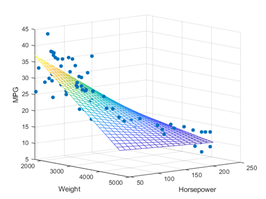Example: Supervised Regression App#
To predict a number for a feature contained in the data, use a supervised regression method (but not logistic regression).
For this example, we’ll slightly modify the previous example. Instead of predicting the category type, we’ll predict the number sepal-length.
| sepal-length | sepal-width | petal-length | petal-width | type | |
|---|---|---|---|---|---|
| 0 | 5.1 | 3.5 | 1.4 | 0.2 | Iris-setosa |
| 1 | 4.9 | 3.0 | 1.4 | 0.2 | Iris-setosa |
| 2 | 4.7 | 3.2 | 1.3 | 0.2 | Iris-setosa |
| 3 | 4.6 | 3.1 | 1.5 | 0.2 | Iris-setosa |
| 4 | 5.0 | 3.6 | 1.4 | 0.2 | Iris-setosa |
| ... | ... | ... | ... | ... | ... |
| 145 | 6.7 | 3.0 | 5.2 | 2.3 | Iris-virginica |
| 146 | 6.3 | 2.5 | 5.0 | 1.9 | Iris-virginica |
| 147 | 6.5 | 3.0 | 5.2 | 2.0 | Iris-virginica |
| 148 | 6.2 | 3.4 | 5.4 | 2.3 | Iris-virginica |
| 149 | 5.9 | 3.0 | 5.1 | 1.8 | Iris-virginica |
The highlighted numbers, ‘sepal-length,’ provides something to predict (dependent variables), and the non-highlighted columns are something by which to make that prediction (independent variables). The big differences from the previous example are as follows:
Data processing (maybe) if we choose to include type as an independent variable, it’ll need to be converted from categorical data into numbers the model can use.
Model Development As we’ll be predicting a number, a regression method will be used instead of a classification method.
Accuracy Metric instead of a simple percentage, we’ll need a measurement of how close the data fits the model. e.g., mean squared error.
Data Exploring and Processing#
As the data is identical, this step will be similar to what was done in the previous example; please refer to it. Focusing on the sepal length, we can certainly see patterns:



